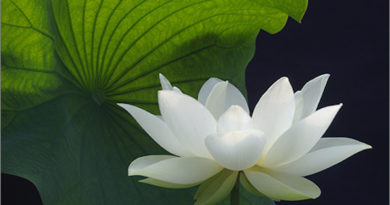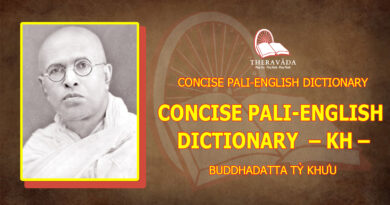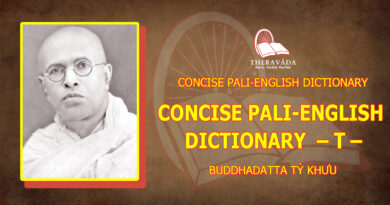NO INNER CORE – ANATTA: UNDERSTANDING ANATTA
NO INNER CORE – ANATTA: UNDERSTANDING ANATTA
The anatta doctrine is one of the most important teachings of Buddhism. It is the most distinctive feature of Buddhism, for as many scholars have recognised, it makes Buddhism different from all other religions. Scholars write that all other religions accept the existence of some kind of spiritual, metaphysical, or psychological entity or agent or being inside and, in some cases, simultaneously outside of sentient beings. That is, most religions accept the existence of a soul or self.
Donald Watson writes: “Of the world’s major religions, only Buddhism denies or is agnostic about the existence of a soul.”
Another scholar Richard Kennedy writes: “According to Christianity, Islam, and Judaism, each soul will be judged at the end of the world…. It is the soul which will determine whether the individual is punished by hell or rewarded by eternal life in heaven…. Buddhism teaches that there is no such thing as a soul or true, permanent self.”
The Encyclopedia Americana writes: “In Buddhism there is no perduring or surviving self such as the atman. Meditation leads to the awareness that the idea of self, or atman, is mere illusion.”
In A Dictionary of Comparative Religion, the teaching of the existence of the soul is traced through every major religion throughout history: primitive animistic, Egyptian, Mesopotamian, Hebrew, Greek religion in Homeric, Orphic, Pythagorean, and Platonic versions; Hindu, Zoroastrian, Chinese, Muslim, Japanese, and Christian. But, as the writers state, “Buddhism, in its classic form, rejected the Hindu concept of atman as the essential, immortal self….”
As we can see, Buddhism is the only major religion that denies the existence of a metaphysical entity which is usually called a self or soul.
Buddhism is divided into two major schools, Theravada and Mahayana, which have, in some cases, major differences. But both schools adhere to the anatta doctrine. H. von Glasenapp writes: “The negation of an imperishable Atman is the common characteristic of all dogmatic systems of the Lesser as well as the Great Vehicle (meaning here Theravada and Mahayana, respectively], and, there is, therefore, no reason to assume that Buddhist tradition which is in complete agreement on this point has deviated from the Buddha’s original teaching.”
Although the anatta doctrine is so important, so distinctive, and supposedly so universally accepted by Buddhists, it is still the most misunderstood, the most misinterpreted, and the most distorted of all the teachings of the Buddha.
Some scholars who have written on Buddhism had a great respect for the Buddha, liked His teachings, revered Him, and honoured Him, but they could not imagine that such a profound thinker had actually denied the existence of a soul. Consequently they have tried to find apparent loopholes in the teachings through which they have tried to insert the affirmation of atta by the Buddha.
For example, two modern scholars, Ananda K. Coomaraswamy and I B. Horner in their book, The Living Thoughts of Gotama the Buddha, have devoted much of the book to the idea that Buddha taught a doctrine of two selves, the great Self, spelled with an upper case ‘S’ to signify the spiritual self or soul, and a small self, the personal ego, spelled with a lower case ‘s’.
They claim that Buddha denied only this personal self or ego when He spoke of anatta. These scholars base their ideas on mistranslation of Pali terms, and later in these lectures I will devote considerable time to analysing the Pali passages which they have mistranslated.
Another scholar John Blofeld, also claims that Buddha was really teaching a doctrine of two selves, one true Self or Soul, and one false personal self or ego. Notice in the following quote how he must clarify that the Zen doctrine of Self or One Mind is not in the reality the Atman of the Hindu Brahmins:-
The doctrine of Atman has always been the centre of Buddhist controversy. There is no doubt that Gautama Buddha made it one of the central points of his teaching, but the interpretations of it are various. The Theravadins interpret it not only as “no self,” but also as “no Self,” thereby denying man both an ego and all participation in something of the nature of Universal Spirit or the One Mind. The Mahayanists accept the interpretation of “egolessness,” holding that the real “Self” is none other than that indescribable “non-entity,” the One Mind; something far less of an “entity” than the Ãtman of the Brahmins.
The “Universal Spirit,” “One Mind,” and “Self” which Blofeld finds within the anatta doctrine are really an Atman, an atta, of a finer substance, “less of an entity ” as he says, but nevertheless an Atman. These ideas of atta are therefore in conflict with the anatta doctrine of the Buddha. As mentioned before, most Mahayanists accept the doctrine of anatta, but later schools of Mahayana, such as the Chinese Zen of which Blofeld writes, may have drifted into a soul-like theory.
The controversy over the anatta doctrine seems to be based on a deep fear of the denial of the existence of a soul. People are often very attached to their lives, so they like to believe that there exists something everlasting, eternal, and permanent inside them. When someone comes along and tells them that there is nothing permanent in them, nothing by which they will continue eternally such as a soul, they may become frightened. They wonder what will become of them in the future – they have the fear of extinction.
Buddha understood this, as we can see in the story of Vacchagotta, who, like many other people, was frightened and confused by the anatta doctrine. Vacchagotta was an ascetic who once went to the Buddha to discuss some important matters. He asked the Buddha, “Is there atta?” Buddha remained silent. Vacchagotta then asked, “Is there no atta” But Buddha again remained silent. After Vacchagotta went away Buddha explained to Ananda why he had remained silent.
Buddha explained that He knew that Vacchagotta was very confused in his thinking about atta, and that if He were to respond that there does exist atta, then He would be expounding the eternalist view the eternal soul theory with which He did not agree. But if He were to say that atta did not exist, then Vacchagotta might think that He was expounding the annihilationist view, the view that a person is nothing but a psychophysical organism which will be completely annihilated at death.
Since this latter view denies kamma, rebirth, and dependent origination, Buddha did not agree with this. Buddha teaches, in fact, that people are reborn with patisandhi, “relinking consciousness,” a rebirth consciousness which does not transmigrate from the previous existence, but which comes into existence by means of conditions included in the previous existences, conditions such as kamma.
Thus a reborn person is not the same as the one who has died, nor is the reborn person entirely different from the one who has died. Most importantly no metaphysical entity no soul, and no kind of spiritual self continues from one existence to another in Buddha’s teaching.
But this teaching was too difficult for Vacchagotta, and Buddha wanted to wait for a time when Vacchagotta would mature in intellect. Buddha was not a computer who gave automatic answers to every Question. He taught according to the circumstances and temperaments of the people, for their benefit.
As it happened, Vacchagotta advanced spiritually through Vipassana meditation, which allowed him to realize the suffering, impermanent, and no-soul nature of all things, and he later became an Arahant. Unfortunately, this story is used by some scholars to try to prove that Buddha did not really deny the existence of atta.
Let us now examine the ideas contained in the term atta, Before Buddha appeared in this world, Brahmanism, which was later to be called Hinduism, prevailed in India. Brãhmanism teaches the doctrine of the existence of atta (in Sanskrit, atman), which is usually translated as soul or self. When Buddha appeared, He claimed that there is no atman. This doctrine was so important that Buddha proclaimed it only five days after His first sermon, the sermon on the Four Noble Truths.
The five disciples who heard that first sermon became “streamwinners” (Sotapannas) persons who have attained the first stage of enlightenment. Five days later, Buddha assembled the five disciples and taught them the anatta doctrine. By the end of that Sutta, all five became Arahants, persons who have attained the highest stage of enlightenment.
What is this atta which the Buddha negated? The word anatta is a combination of two words: an and atta. An means not or no, and atta is usually translated as soul or self (sometimes with upper case ‘S’ to signify a spiritual entity). But atta has a wide range of meanings, which we will now examine. These terms are discussed in two famous books of Hindu scripture, the Upanishads and the Bhagavad Gita. Many views of atta are found in the Buddhist Brahmajala Sutta, which I will discuss later.
Atta is the inner core of anything. The inner core of a tree is the hardest part and thus the core of something can imply permanency The core may also imply the best part of something, the part which is the essence, the part which is pure, real, beautiful, and enduring. The idea of atta as the core of things is found in the Chandogya and Brihadaranyaka Upanishads.’
Another implication of atta is that of authority Authority is the ability to make others follow orders. If anything is to be called atta, it must have the power to exercise authority over the nature of things, as stated in the Kena Upanishad. In addition, atta is not subject to any other authority: it is the highest authority (sayamvasi) one who is his own master. It is like a lord or owner (sami). Atta is the lord of ourselves. It is distinct from ourselves and abides in ourselves.
It is the dweller (nivasi) which is not part of the five aggregates. Atta is also the agent of action, a doer (karaka) and it is atta which actually does everything, good or bad. Atta is that by which we act, that by which we enjoy or suffer In ignorance we identify ourselves with the body and ego, forgetting that we are really atta.
When we do something, it is really at the command of atta, but we ignorantly believe that we as individuals actually control our lives. Atta is thus a director and an experiencer.”
Another meaning of atta is that of soul, a spiritual entity inside of all people. The soul, called atman in Hindu scriptures, is the individual self, and it is identical with the Universal Self, the Supreme Being, called Brahman. Atman resides in everyone and in every living being. Like Brahman, atman is eternal. When the body dies, atman moves to another body and makes that body its new home.
In this way it moves from one body to another discarding the worn-out body and taking a new one. Liberation is, according to Hinduism, the realisation that atman is identical with the Universal Atman or Brahman, or that the individual atman is part of Brahman’.
Atman is eternal – no one can kill or wound atman. In the Bhagavad Gita, Krishna, one incarnation of the god Vishnu, has this in mind when he instructs the great warrior Arjuna, to go into battle. Arjuna was at first reluctant to go into battle in order to fight against his own cousins, but Krishna tells him that no weapon can cut atman, no fire can burn atman. Even if you kill someone, you kill only the body:
“If any man thinks he slays, and if another thinks he is slain, neither knows the way of truth, The Eternal in man cannot kill; the Eternal in man cannot die. He is never born, and he never dies. He is in Eternity: he is forever more.”
Krishna then urges Arjuna to do his honourable duty as a member of the warrior caste and go into battle, which Arjuna does. Buddha denied the atman theory According to Buddha, there is nothing we can call an inner core which is eternal and blissful. There is also nothing we can call upon to exercise authority over the nature of things. In Buddhism, there is no doer apart from doing, and no experiencer apart from the experiencing. There is nothing or no one which is omnipotent because everything is at the mercy of the constant creation and dissolution of conditioned things.
Buddha taught that there are only five aggregates (khandhas):
1) Corporeality (material process, or form)
2) Feelings;
3) Perceptions;
4) Metal formations; and
5) Consciousness.
Less specifically we may say that there are only two groups of phenomena in this existence: mind and matter, nama and rupa. Apart from mind and matter there exists nothing whatsoever that we can call atta. The only thing that exists outside of the realm of nama and rupa is the unconditioned (asankhata) Nibbana, Absolute Truth, but. as I will discuss later in these lectures, even Nibbana is anatta.
Buddha taught that, for us, there are only the five aggregates. We are a compound of five aggregates, and after we analyse and observe them one by one with the deep insight of meditation, we will realise that there remains nothing: no soul, no self, apart from the aggregates. The combination of the five aggregates is what we call a person, a being, a man, or a woman.
There is nothing apart from the five aggregates – corporeality feelings, perceptions, mental formations, and consciousness – which are interacting and dependent upon each other. No director, no doer no experiencer, and no essence can be found. Atta is merely an idea which has no corresponding reality whatsoever.
In the sutras, we find a story of a very famous ascetic-scholar named Saccaka. One day he heard that Buddha taught the anatta doctrine. Since he was a very sharp debater he decided that he would go to the Buddha and convince Him that the anatta doctrine was wrong. He was very confident; he claimed that if he were to debate with a stone pillar, that pillar would sweat from fear. He claimed that, just as a strong man takes a goat and flings it around his shoulders, so he would take hold of Gotama and fling Him around in debate.
Saccaka and his followers went to the Buddha and there exchanged greetings. He asked Buddha to explain the doctrines He taught. Buddha replied that He taught anatta. Saccaka countered, “No. There is atta. The five aggregates are atta.” Buddha replied, “Do you really think that rupa (corporeality) is atta?” As it happened, Saccaka was very ugly, and if he said that corporeality was atta, then Buddha could counter, “Then why don’t you make yourself more handsome!”
Thus Saccaka was forced to say that rupa is not atta. Here we can see Buddha striking down several characteristics that are attributed to the atta. If Saccaka had an atta, he could call upon it to exercise authority and power in order to change his appearance. After all, atta is identical to Brahman, the supreme ruler the infinite, omnipotent creator and source of all things, as explained in the Bhagavad Gita.
But, according to Buddha, there exist only the five aggregates, the five khandhas, and these are not atta because they are subject to the laws of impermanence, suffering, and no-soul. Rupa (material form) is not atta; it is not master and ruler of itself, and it is subject to affliction. The other khandhas – feeling, perception, mental formations, and consciousness – are also subject to the same laws. Sacccaka was therefore defeated.
Although it may be easy to understand that rúpa (material form) is not atta, some people may find it difficult to understand why the other khandhas – feeling, perception, mental formations, and consciousness – which we may summarise as simply nama (mind) do not constitute an entity which can be called atta. After all, many people believe that mind and soul are identical or interrelated, and they define mind and/or soul as that part of a person which gives life and consciousness to the physical body and they further believe that, as such, it is the spiritual and psychological centre of the person.
But, according to the Buddha, nama is not atta for the same reasons that rupa is not atta: nama is equally subject to the laws of impermanence, suffering, and no-soul, as we shall study further when we analyse the Anatta-lakkhana Sutta in depth. Buddha treats nama and rupa equally, and they are mutually dependent upon each other:
“Just as a wooden puppet, though unsubstantial, lifeless, and inactive, may by means of pulling strings be made to move about, stand up, and appear full of life and activity; just so are mind and body, as such, something empty, lifeless and inactive; but by means of their mutual working together, this mental and bodily combination may move about, stand up, and appear full of life and activity.
Furthermore, we must remember that nama-rupa or khandhas are merely abstract classifications made by the Buddha, and, as such, they have no real existence as groups. That is, there is never the functioning of an entire entity or group known as corporeality or feeling or perception or mental formations or consciousness, but only the functioning of individual representatives of these groups.
For example, with one unit of consciousness, only one single kind of feeling can be associated. Two different units of perception cannot arise at the same moment, and only one kind of consciousness, for example seeing consciousness, can arise at one time. A smaller or larger number of mental formations can arise with every state of consciousness.
The groups never arise as a totality; only constituents or bits from a certain group can arise depending on conditions. There are no integrally functioning groups that can be called a self or a mind. Moreover the single constituents of these apparent groups are all equally subject to the laws of impermanence, suffering, and no-soul.
Another way to study the Question of why nama is not atta is simply to go back to the definition of khandhas given by the Buddha in Samyutta Nikaya XX, 56. Here we will see that the four khandhas, which can be classified simply as nama (mind) are in no way to be understood as an abiding mind substance or as anything that can be called atta. Rather, the khandhas are completely interdependent, and the constituents of each group condition the arising of the others. There is no self existing, abiding entity in any part of the following definition, but only constituents which mutually condition each other and arise only when they interact:
“What, 0 monks, is the corporeality-group?
The four primary elements and corporeality depending thereon….
What, 0 monks, is the feeling-group?
There are six classes of feeling: due to visual impression, to sound impression, to odour impression, to taste impression, to bodily impression, and to mind impression….
What, 0 monks, is the perception-group?
There are six classes of perception: perception of visual objects, of sounds, of odours. of tastes, of bodily impressions, and of mental impressions….
What, 0 monks, is the group of mental formations?
There are six classes of volitional states: with regard to visual objects, to sounds, to odours, to tastes, to bodily impressions, and to mind objects….
What, 0 monks, is the consciousness-group?
There are six classes of consciousness: eye-consciousness, ear-consciousness. nose-consciousness, tongue-consciousness. body-consciousness, and mind-consciousness.”
Based on the above definitions, it is easy to see that nothing which can be called atta can be found in the workings of rupa or nama. Still another way in which the nature of nama and rupa is analysed is to be found in the Abhidhamma, which is highly recommended for anyone who wants to understand Buddhism thoroughly.
This is the most comprehensive and analytical study of all phenomena given by the Buddha. Here Buddha analyses nama and rupa into three groups of absolute realities, which are 89 types of consciousness (cittas), 52 mental factors (cetasikas), and 28 material properties (rupa). Here too, there is no abiding mind substance or atta, but only the interdependent workings of the constituents of these groups.









